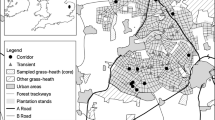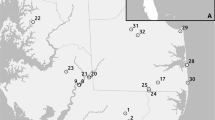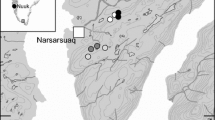Abstract
Recent declines in invertebrates are linked to anthropogenic global change drivers thus land use planning that considers invertebrate conservation is necessary. Although most animals are invertebrates, conservation initiatives largely ignore these groups in part because of a paucity of studies addressing their diversity patterns. Biosphere Reserves provide an holistic approach to conservation planning. Here we explore the covariates that underlie beetle and spider diversity across the largest Biosphere Reserve in South Africa and use this model to predict compositional turnover across the reserve using Generalized Dissimilarity Modelling (GDM). We then use these patterns to assess the proportion of the ecological environments, scaled using beetle and spider assemblages, that is included in either core or buffer zones. The GDM model explained 53% of the variation in observed compositional turnover. Important local-scale drivers of turnover were leaf litter and organic content of the soil, while broad-scale co-variables were isothermality and mean diurnal range. Buffer zones increased conservation coverage by between 50 and 100%, depending on the planning scenario involved and complimented regional conservation plans. However, local conservation practices rarely reflect that of regional planning exercises, and initiatives should focus on monitoring compliance that considers both landscape and local processes.
Implications for insect conservation
Conservation efforts should not only focus on core areas in Biosphere Reserves. Managing buffer zones must receive similar if not more attention due to the larger anthropogenic footprint.





Similar content being viewed by others
References
Barton PS, Manning AD, Gibb H, Lindenmayer DB, Cunningham SA (2010) Fine-scale heterogeneity in beetle assemblages under co‐occurring Eucalyptus in the same subgenus. J Biogeogr 37(10):1927–1937. https://doi.org/https://onlinelibrary.wiley.com/doi/full/https://doi.org/10.1111/j.1365-2699.2010.02349.x
Barton PS, Manning AD, Gibb H, Wood JT, Lindenmayer DB, Cunningham SA (2011) Experimental reduction of native vertebrate grazing and addition of logs benefit beetle diversity at multiple scales. J Appl Ecol 48(4): 943–951. https://doi.org/https://besjournals.onlinelibrary.wiley.com/doi/https://doi.org/10.1111/j.1365-2664.2011.01994.x
Bellard C, Bertelsmeier C, Leadley P, Thuiller W, Courchamp F (2012) Impacts of climate change on the future of biodiversity. Ecol lett 15(4):365–377. https://doi.org/https://onlinelibrary.wiley.com/doi/https://doi.org/10.1111/j.1461-0248.2011.01736.x
Burnham KP, Anderson DR (2004) Multimodel inference: understanding AIC and BIC model selection. Social Methods Res 37:261–304. https://doi.org/10.1177/0049124104268644
Cardoso P, Barton PS, Birkhofer K, Chichorro F, Deacon C, Fartmann T, Fukushima CS, Gaigher R, Habel JC, Hallmann CA, Hill MJ, Hochkirch A, Kwak ML, Mammola S et al (2020) Scientists’ warning to humanity on insect extinctions. Biol Conserv 242:108426. https://doi.org/10.1016/j.biocon.2020.108426
Carvalho JC, Cardoso P, Crespo LC, Henriques S, Carvalho R, Gomes P (2011) Determinants of beta diversity of spiders in coastal dunes along a gradient of mediterraneity. Divers Distrib 17(2): 225–234. https://doi.org/https://onlinelibrary.wiley.com/doi/full/10.1111/j.1472-4642.2010.00731.x
Chao A, Jost L (2012) Coverage-based rarefaction and extrapolation: standardizing samples by completeness rather than size. Ecology 93(12):2533–2547. https://doi.org/10.1890/11-1952.1
Classen AT, Sundqvist MK, Henning JA, Newman GS, Moore JA, Cregger MA, Moorhead LC, Patterson CM (2015) Direct and indirect effects of climate change on soil microbial and soil microbial-plant interactions: what lies ahead? Ecosphere 6(8):1–21. https://doi.org/10.1890/ES15-00217.1
Constant NL, Bell S (2017) Governance, participation and local perceptions of protected areas: unwinding traumatic nature in the Blouberg Mountain Range. Environ Values 26(5):539–559. https://doi.org/10.3197/096327117X15002190708100
De Boeck P, Bakker M, Zwitser R, Nivard M, Hofman A, Tuerlinckx F, Partchev I (2011) The estimation of item response models with the lmer function from the lme4 package in R. J Stat Softw 39(12):1–28
Desmet PG, Holness S, Skowno A, Egan VT (2013) Limpopo conservation plan. Contract Number LEDET/2216/2012. Limpopo Department of Economic Development, Environment and Tourism (LEDET). https://doi.org/https://conservationcorridor.org/cpb/Desmet_et_al_2013.pdf. Accessed 11 May 2021
Díaz S, Settele J, Brondízio E, Ngo H, Guèze M, Agard J, Arneth A, Balvanera P, Brauman K, Butchart S, Chan K (2020) Summary for policymakers of the global assessment report on biodiversity and ecosystem services of the Intergovernmental Science-Policy Platform on Biodiversity and Ecosystem Services. https://doi.org/https://uwe-repository.worktribe.com/output/1493508. Accessed 10 May 2021
Dippenaar-Schoeman A, Van den Berg A, Lyle R, Haddad C, Foord S, Lotz L (2012) Die diversiteit van Suid-Afrikaanse spinnekoppe (Arachnida: Araneae): Dokumentering van ’n nasionale opname., Suid-Afrikaanse Tydskrif vir Natuurwetenskap en Tegnologie 32(1): 1–7. https://doi.org/https://journals.co.za/doi/abs/https://doi.org/10.4102/satnt.v32i1.375
Dippenaar-Schoeman AS (2014) Field guide to the spiders of South Africa. Lapa, Pretoria
Ferrier S, ManionG, Elith J, Richardson K (2007) Using generalized dissimilarity modelling to analyse and predict patterns of beta diversity in regional biodiversity assessment. Divers Distrib 13:252–264
Ferrier S, Powell GV, Richardson KS, Manion G, Overton JM, Allnutt TF, Cameron SE, Mantle K, Burgess ND, Faith DP, Lamoreux JF (2004) Mapping more of terrestrial biodiversity for global conservation assessment. Bioscience 54(12):1101–1109. https://doi.org/https://onlinelibrary.wiley.com/doi/full/https://doi.org/10.1111/j.1472-4642.2007.00341.x
Fick SE, Hijmans RJ (2017) WorldClim 2: new 1-km spatial resolution climate surfaces for global land areas. Int J Climatol 37(12):4302–4315. https://doi.org/10.1002/joc.5086
Fitzpatrick M, Lisk M (2016) Using the R package gdm to analyse and map biodiversity patterns. https://doi.org/https://cran.r-project.org/web/packages/gdm/vignettes/gdmVignette.pdf. Accessed 1 May 2021
Foord S, Dippenaar-Schoeman AS, Haddad CR, Schoeman C, Hahn N, Lyle R (2019) Spider checklist for the Blouberg, in the Vhembe Biosphere Reserve, South Africa. Afr Biodivers Conserv 49(1):1–13. https://doi.org/10.4102/abc.v49i1.2455
Foord SH, Dippenaar-Schoeman AS (2016) The effect of elevation and time on mountain spider diversity: a view of two aspects in the Cederberg mountains of South Africa. J Biogeogr 43(12): 2354–2365. https://doi.org/https://onlinelibrary.wiley.com/doi/full/https://doi.org/10.1111/jbi.12817
Foord SH, Dippenaar-Schoeman AS, Van der Merwe M (2002) A check list of the spider fauna of the Western Soutpansberg, South Africa (Arachnida: Araneae). Koedoe 45(2):35–43. https://doi.org/10.4102/koedoe.v45i2.25
Foord SH, Gelebe V, Prendini L (2015) Effects of aspect and altitude on scorpion diversity along an environmental gradient in the Soutpansberg, South Africa. J Arid Environ 113:114–120. https://doi.org/10.1016/j.jaridenv.2014.10.006
Foord SH, Dippenaar-Schoeman AS, Haddad CR, Lyle R, Lotz LN, Sethusa T, Raimondo D (2020) The South African National Red List of spiders: patterns, threats, and conservation. J Arachnol 48(2):110–118. https://doi.org/10.4102/koedoe.v60i1.1486
Fox R (2013) The decline of moths in Great Britain: a review of possible causes. Insect Conserv Divers 6(1):5–19. https://doi.org/10.1111/j.1752-4598.2012.00186.x
Gaigher R, Samways MJ (2014) Landscape mosaic attributes for maintaining ground-living spider diversity in a biodiversity hotspot. Insect Conserv Divers 7:470–479. https://doi.org/10.1111/icad.12070
Gaston KJ (2000) Global patterns in biodiversity. Nature 405(6783):220–227. https://doi.org/https://www.nature.com/articles/35012228
Gering JC, Crist TO (2002) The alpha–beta–regional relationship: providing new insights into local–regional patterns of species richness and scale dependence of diversity components. Ecol Lett 5(3):433–444. https://doi.org/10.1046/j.1461-0248.2002.00335.x
Gerlach J, Samways M, Pryke J (2013) Terrestrial invertebrates as bioindicators: an overview of available taxonomic groups. J Insect Conserv 17(4): 831–850. https://doi.org/https://link.springer.com/article/10.1007/s10841-013-9565-9
Gough L, Grace JB, Taylor KL (1994) The Relationship between Species Richness and Community Biomass: The Importance of Environmental Variables. Oikos 70(2):271–279. https://doi.org/10.2307/3545638
Gove AD, Majer JD, Rico-Gray V (2005) Methods for conservation outside of formal reserve systems: The case of ants in the seasonally dry tropics of Veracruz. Mexico Biol Conserv 126(3):328–338. https://doi.org/10.1016/j.biocon.2005.06.008
Haddad CR (2009) Vendaphaea, a new dark sac spider genus apparently endemic to the Soutpansberg Mountains, South Africa (Araneae: Corinnidae). Afr Invertebr 50(2):269–278. https://doi.org/10.5733/afin.050.0204
Hahn N (2017) Endemic flora of the Soutpansberg, Blouberg and Makgabeng. S Afr J Bot 113:324–336. https://doi.org/10.1016/j.sajb.2017.09.006
Hahn N (2018) An historic account of the extinct high rainfall grasslands of the Soutpansberg, South Africa. Trans R Soc S Afr 73(1):20–32. https://doi.org/10.1080/0035919X.2017.1346528
Hallmann CA, Sorg M, Jongejans E, Siepel H, Hofland N, Schwan H, Stenmans W, Müller A, Sumser H, Hörren T, Goulson D (2017) More than 75 % decline over 27 years in total flying insect biomass in protected areas. PLoS ONE. https://doi.org/10.1371/journal.pone.0185809
Hopper SD (2009) OCBIL theory: towards an integrated understanding of the evolution, ecology and conservation of biodiversity on old, climatically buffered, infertile landscapes. Plant Soil 322:49–86. https://doi.org/10.1007/s11104-009-0068-0
Hopper SD, Silveira FA, Fiedler PL (2016) Biodiversity hotspots and Ocbil theory. Plant Soil 403(1–2):167–216. https://doi.org/10.1007/s11104-015-2764-2
Hutcheson J (1990) Characterization of terrestrial insect communities using quantified, Malaise-trapped Coleoptera. Ecol Entomol 15:143–151. https://doi.org/10.1111/j.1365-2311.1990.tb00795.x
Ishwaran N, Persic A, Tri NH (2008) Concept and practice: the case of UNESCO biosphere reserves. Int J Environ Sci Dev 7(2):118–131. https://doi.org/10.1504/IJESD.2008.018358
Janion-Scheepers C, Measey J, Braschler B, Chown SL, Coetzee L, Colville JF, Dames J, Daviesh AB, Davies SJ, Davis ALV, Dippenaar-Schoeman AS, Duffy GA, Fourie D, Griffiths C, Haddad CR, Hamer M, Herbert DG, Hugo-Coetzee EA, Jacobs A, Jacobs K, van Rensburg CJ, Lamania A, Lotze LN, vdM Louw S, Lyle R, Malan AP, Marais M, Neethling JA, Nxele TC, Pliskop DJ, Prendini L, Rink AN, Swart A, Theron P, Truter M, Ueckermann E, Uys VM, Villet MH, Willows-Munro S, Wilson JRU (2016) Soil biota in a megadiverse country: Current knowledge and future research directions in South Africa. Pedobiologia 59(3):129–174. https://doi.org/10.1016/j.pedobi.2016.03.004
Kati V, Devillers P, Dufrêne M, Legakis A, Vokou D, Lebrun P (2004) Hotspots, complementarity or representativeness? Designing optimal small-scale reserves for biodiversity conservation. Biol Conserv 120(4):471–480. https://doi.org/10.1016/j.biocon.2004.03.020
Kamiński MJ, Schoeman CS (2018) Taxonomic revision of a darkling beetle genus Anaxius (Tenebrionidae: Pedinini: Helopinina). Zootaxa 4455(3):471–485. https://doi.org/10.11646/zootaxa.4455.3.4
Kaufman L, Rousseeuw PJ (2009) Finding groups in data: an introduction to cluster analysis. Wiley, New York
Koleff P, Gaston KJ, Lennon JJ (2003) Measuring beta diversity for presence–absence data. J Anim Ecol 72:367–382. https://doi.org/10.1046/j.1365-2656.2003.00710.x
Kremen C, Merenlender AM (2018) Landscapes that work for biodiversity and people. Science. https://doi.org/10.1126/science.aau6020
Leather SR (2017) “Ecological Armageddon”-more evidence for the drastic decline in insect numbers. Ann Appl Biol 172(1):1–3. https://doi.org/10.1111/aab.12410
Lombard AT, Cowling RM, Pressey RL, Rebelo AG (2003) Effectiveness of land classes as surrogates for species in conservation planning for the Cape Floristic Region. Biol Conserv 112(1–2):45–62. https://doi.org/10.1016/S0006-3207(02)00422-6
MacLeod A, Wratten SD, Sotherton NW, Thomas MB (2004) ‘Beetle banks’ as refuges for beneficial arthropods in farmland: long-term changes in predator communities and habitat. Agric For Entomol 6(2):147–154. https://doi.org/10.1111/j.1461-9563.2004.00215.x
Mammola S, Cardoso P, Angyal D, Balázs G, Blick T, Brustel H, Carter J, Ćurčić S, Danflous S, Dányi L, Déjean S (2019) Local-versus broad-scale environmental drivers of continental β-diversity patterns in subterranean spider communities across Europe. Proc R Soc B. https://doi.org/10.1098/rspb.2019.1579
Maudsley M, Seeley B, Lewis O (2002) Spatial distribution patterns of predatory arthropods within an English hedgerow in early winter in relation to habitat variables. Agric Ecosyst Environ 89(1–2):77–89. https://doi.org/10.1016/S0167-8809(01)00320-6
Mittermeier RA, Turner WR, Larsen FW, Brooks TM, Gascon C (2011) Global biodiversity conservation: the critical role of hotspots. In: Zachos FE, Habel JC (eds) Biodiversity hotspots: distribution and protection of conservation priority areas. Springer, Berlin
Modiba RV, Joseph GS, Seymour CL, Fouché P, Foord SH (2017) Restoration of riparian systems through clearing of invasive plant species improves functional diversity of Odonate assemblages. Biol Conserv 214:46–54. https://doi.org/10.1016/j.biocon.2017.07.031
Mucina L, Rutherford MC (2006) The vegetation of South Africa, Lesotho and Swaziland. Strelitzia 19. South African National Biodiversity Institute, Pretoria
Munyai TC, Foord SH (2015) An inventory of epigeal ants of the western Soutpansberg Mountain Range, South Africa. Koedoe 57(1):1–12. https://doi.org/10.4102/koedoe.v57i1.1244
Nakagawa S, Schielzeth H (2010) Repeatability for Gaussian and non-Gaussian data: a practical guide for biologists. Biol Rev 85(4):935–956. https://doi.org/10.1111/j.1469-185X.2010.00141.x
Njovu HK, Peters MK, Schellenberger Costa D, Brandl R, Kleyer M, Steffan-Dewenter I (2019) Leaf traits mediate changes in invertebrate herbivory along broad environmental gradients on Mt. Kilimanjaro, Tanzania. J Anim Ecol 88(11):1777–1788. https://doi.org/10.1111/1365-2656.13058
Nyffeler M, Birkhofer K (2017) An estimated 400–800 million tons of prey are annually killed by the global spider community. Sci Nat 104:30. https://doi.org/10.1007/s00114-017-1440-1
O’Donnell MS, Ignizio DA (2012) Bioclimatic predictors for supporting ecological applications in the conterminous United States. US Geological Survey Data Series 691(10): 4–9. https://doi.org/https://pubs.usgs.gov/ds/691/. Accessed 1 May 2021
Oliver I, Beattie AJ, York A (1998) Spatial fidelity of plant, vertebrate, and invertebrate assemblages in multiple-use forest in eastern Australia. Conserv Biol 12(4):822–835. https://doi.org/10.1111/j.1523-1739.1998.97075.x
Pennifold MG, Williams KJ, Pinder AM, Harwood TD, Manion G, Ferrier S (2017) Whole-landscape modelling of compositional turnover in aquatic invertebrates informs conservation gap analysis: An example from south‐western Australia. Freshw Biol 62:1359–1376. https://doi.org/10.1111/fwb.12949
Picker M, Griffiths C, Weaving A (2004) Field Guide to Insects of Southern Africa. Struik, Cape Town
Pool-Stanvliet R (2013) A history of the UNESCO Man and the Biosphere Programme in South Africa. S Afr J Sci 109(9–10):01–06. https://doi.org/10.1590/sajs.2013/a0035
Pryke JS, Roets F, Samways MJ (2016) Wild herbivore grazing enhances insect diversity over livestock grazing in an African grassland system. PLoS ONE. https://doi.org/10.1371/journal.pone.0164198
Qian H, Ricklefs RE (2012) Disentangling the effects of geographic distance and environmental dissimilarity on global patterns of species turnover. Glob Ecol Biogeogr 21(3):341–351. https://doi.org/10.1111/j.1466-8238.2011.00672.x
R Core Team (2021) R: A language and environment for statistical computing. R Foundation for Statistical Computing, Vienna, Austria. https://doi.org/http://www.R-project.org/. Accessed 1 May 2021
Ramos CS, Isabel Bellocq M, Paris CI, Filloy J (2018) Environmental drivers of ant species richness and composition across the Argentine Pampas grassland. Austral Ecol 43(4):424–434. https://doi.org/10.1111/aec.12579
Reyers B, Jaarsveld AV, Krüger M (2000) Complementarity as a biodiversity indicator strategy. Proc R Soc Lond [Biol] 267(1442):505–513. https://doi.org/10.1098/rspb.2000.1029
Rouget M (2003) Measuring conservation value at fine and broad scales: implications for a diverse and fragmented region, the Agulhas Plain. Biol Conserv 112(1–2):217–232. https://doi.org/10.1016/S0006-3207(02)00415-9
Samways MJ, McGeoch MA, New TR (2010) Insect conservation: a handbook of approaches and methods. Oxford University Press, Oxford
Samways MJ, Barton PS, Birkhofer K, Chichorro F, Deacon C, Fartmann T, Fukushima CS, Gaigher R, Habel JC, Hallmann CA, Hill MJ et al (2020) Solutions for humanity on how to conserve insects. Biol Conserv 242:108427. https://doi.org/10.1016/j.biocon.2020.108427
Sánchez-Bayo F, Wyckhuys KA (2019) Worldwide decline of the entomofauna: A review of its drivers. Biol Conserv 232:8–27. https://doi.org/10.1016/j.biocon.2019.01.020
Sauberer N, Zulka KP, Abensperg-Traun M, Berg HM, Bieringer G, Milasowszky N, Moser D, Plutzar C, Pollheimer M, Storch C, Tröstl R (2004) Surrogate taxa for biodiversity in agricultural landscapes of eastern Austria. Biol Conserv 117(2):181–190. https://doi.org/10.1016/S0006-3207(03)00291-X
Saxer G, Doebeli M, Travisano M (2009) Spatial structure leads to ecological breakdown and loss of diversity. Proc R Soc Lond [Biol] 276:2065–2070. https://doi.org/10.1098/rspb.2008.1827
Schaffers AP, Raemakers IP, Sýkora KV, Ter Braak CJ (2008) Arthropod assemblages are best predicted by plant species composition. Ecology 89(3):782–794. https://doi.org/10.1890/07-0361.1
Scheffers BR, Evans TA, Williams SE, Edwards DP (2014) Microhabitats in the tropics buffer temperature in a globally coherent manner. Biol Lett 10(12):20140819. https://doi.org/10.1098/rsbl.2014.0819
Schoeman CS, Samways MJ (2011) Synergisms between Alien Trees and the Argentine Ant on Indigenous Ant Species in the Cape Floristic Region, South Africa. Afr Entomol 19(1):96–105. https://doi.org/10.4001/003.019.0117
Schoeman CS, Foord SH (2012) Deciding on an appropriate scale for conservation activities: partitioning alpha and beta ant diversity in North-West Province, South Africa (Formicidae: Hymenoptera). Trans R Soc S Afr 67(1):1–10. https://doi.org/10.1080/0035919X.2011.641690
Schoeman CS, Tshililo P, Foord SH, Hamer M (2018) Annotated checklist of Carabidae (Insecta: Coleoptera) of the Vhembe Biosphere Reserve, South Africa. https://doi.org/10.13140/RG.2.2.33610.06089
Schoeman CS, Hahn N, Hamer M, Foord SH (2019a) Regional invertebrate cross-and within-taxon surrogacy are scale and taxon dependent. Trans R Soc S Afr 75(1):23–32. https://doi.org/10.1080/0035919X.2019.1658656
Schoeman CS, Cory Toussaint D, Tshililo P, Foord SH, Hamer M (2019b) Darkling beetles of the bushveld: an annotated checklist of the Tenebrionidae of the Vhembe Biosphere Reserve, South Africa (Coleoptera). https://doi.org/10.13140/RG.2.2.29054.33604
Schönhofer AL (2008) On harvestmen from the Soutpansberg, South Africa, with description of a new species of Monomontia (Arachnida: Opiliones). Afr Invertebr 49(2):109–126. https://doi.org/10.5733/afin.049.0206
Sieh T, Ma K, Chao A (2014) iNEXT: iNterpolation and EXTrapolation for species diversity. R package version 2.0. https://doi.org/http://chao.stat.nthu.edu.tw/blog/software-download. Accessed 1 May 2021
Soininen J (2016) Spatial structure in ecological communities–a quantitative analysis. Oikos 125(2):160–166. https://doi.org/10.1111/oik.02241
Su JC, Debinski DM, Jakubauskas ME, Kindscher K (2004) Beyond species richness: community similarity as a measure of cross-taxon congruence for coarse‐filter conservation. Conserv Biol 18(1):167–173. https://doi.org/10.1111/j.1523-1739.2004.00337.x
Tuanmu MN, Jetz W (2014) A global 1-km consensus land‐cover product for biodiversity and ecosystem modelling. Glob Ecol Biogeogr 23(9):1031–1045. https://doi.org/10.1111/geb.12182
UNESCO (2021) Biosphere Reserves in Africa. https://doi.org/https://en.unesco.org/biosphere/africa/. Accessed 1 May 2021
Van Schalkwyk J, Pryke JS, Samways MJ, Gaigher R (2019) Complementary and protection value of a Biosphere Reserve buffer zone for increasing local representativeness of ground-living arthropods. Biol Conserv 239:108292. https://doi.org/10.1016/j.biocon.2019.108292
Vhembe DM (2017) Vhembe District Bioregional Plan. Compiled by: Limpopo Department of Economic Development, Environment and Tourism (LEDET). http://www.nuleafsa.co.za/wp-content/uploads/2018/01/Vhembe-Bioregional-Plan_rev4_Dec-2017_name-changes.pdf. Accessed 1 May 2021
Willig MR, Kaufman DM, Stevens RD (2003) Latitudinal gradients of biodiversity: pattern, process, scale, and synthesis. Annu Rev Ecol Evol Syst 34(1):273–309. https://doi.org/10.1146/annurev.ecolsys.34.012103.144032
Wise DH (2006) Cannibalism, food limitation, intraspecific competition, and the regulation of spider populations. Annu Rev Entomol 51:441–465. https://doi.org/10.1146/annurev.ento.51.110104.150947
Woodroffe R, Ginsberg JR (1998) Edge effects and the extinction of populations inside protected areas. Science 280(5372):2126–2128. https://doi.org/10.1126/science.280.5372.2126
Acknowledgements
We are particularly grateful to all landowners who allowed us to work on their properties. We acknowledge the SARChI Chair for Biodiversity and Change and Directorate for Research and Research Innovation at the University of Venda for logistic and financial support. We are very grateful to Ansie Dippenaar-Schoeman, Ruth Muller and Adrian Davis for species identification. We thank Michelle Hamer, Dawn Corey Toussaint and Danie Booyens for providing insights and support during this study.
Author information
Authors and Affiliations
Corresponding author
Ethics declarations
Ethical approval
Specimens were collected on permit no. CPM-005-00005, provided by Limpopo Department of Economic Development, Environment and Tourism. The research leading to these results received funding from the University of Venda Research and Publications Committee under grant no P109. The authors declare they have no financial interests.
Additional information
Publisher’s Note
Springer Nature remains neutral with regard to jurisdictional claims in published maps and institutional affiliations.
Supplementary Information
Below is the link to the electronic supplementary material.
Appendix
Appendix
Map showing (a) localities referred to in text including the Soutpansberg mountain range and the Limpopo Valley, and (b) sites (black dots) within vegetation units (illustrated in different colours) in the Vhembe Biosphere Reserve (VBR), Limpopo Province, South Africa. Makhado Sweet Bushveld (3 sites), Soutpansberg Summit Sourveld (4 sites), Northern Mistbelt Forest (4 sites), Roodeberg Bushveld (2 sites), Soutpansberg Mountain Bushveld (4 sites), Musina Mopane Bushveld (2 sites), and Limpopo Ridge Bushveld (1 site)

Rights and permissions
About this article
Cite this article
Schoeman, C.S., Foord, S.H. Buffer zones maximize invertebrate conservation in a Biosphere Reserve. J Insect Conserv 25, 597–609 (2021). https://doi.org/10.1007/s10841-021-00326-7
Received:
Accepted:
Published:
Issue Date:
DOI: https://doi.org/10.1007/s10841-021-00326-7




